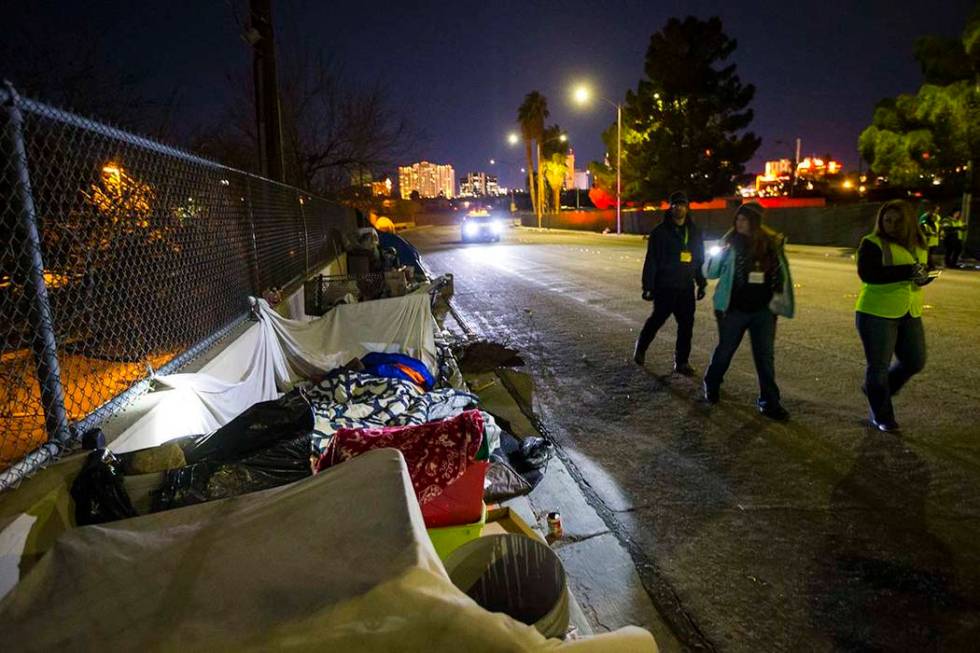Volunteers fan out to count Las Vegas’ homeless people — PHOTOS

A file of volunteers and workers counting the homeless in Las Vegas on Tuesday night passed beneath a railroad overpass on Washington Avenue near Main Street without stopping, but William Kight paused to take a closer look.
Shining his flashlight up into small caverns beneath the bridge deck, he spotted the corner of a green blanket sticking out. Within moments, several other people tucked into the cramped recesses were sitting up or rolling over in their sleeping bags or blankets and shielding their faces from the group’s lights. Moments later, all had been counted.
“For single people, this is the safest place to sleep,” Kight, 48, said to one volunteer, adjusting his black rectangular glasses.
Kight’s knowledge of homelessness was hard won. If this had been the 2018 Southern Nevada Homeless Census instead of this year’s, he would have been one of those being tallied.
He’s now been off the streets for eight months and is working at the city of Las Vegas’ homeless courtyard.
“I have the pulse of the community,” he said during Tuesday night’s count. “I know where they go to stay protected, and now it’s my time to give back.”
Kight was one of more than 300 volunteers scouring Clark County from 10 p.m. Tuesday to 4 a.m. Wednesday as part of the census. A separate count of homeless youths occurred on Wednesday from 7:30 a.m. to 2:30 p.m.
All told, the groups covered 708 census tracks, said Michele Fuller-Hallauer, social service manager at the county’s Department of Social Service, who has been involved in the annual count since 2005.
Federally mandated count
The homeless census, mandated by the U.S. Department of Housing and Urban Development, is crucial for the county to receive some federal aid. This year, the county received about $14 million from the federal government for services in the community, Fuller-Hallauer said.
Last year, the homeless census counted 6,083 people living inside Clark County’s shelters or on local streets, the county announced in July. The results of this year’s count won’t be known until spring.
Last year’s total was 400 fewer than in 2017, when Clark County ranked eighth in the U.S. for largest homeless population. But some of that decline was likely the result of a bookkeeping change instituted by the feds.
The 2017 survey also found that the percentage of homeless living without shelter — a little less than two-thirds of the total — in Clark County was higher than the U.S. average.
That led the county to take a fresh look at its services and brainstorm new approaches to encourage people to come in from the heat and cold.
One aspect of that rethink, Fuller-Hallauer said, was working with emergency shelters to train workers to become more collaborative on outreach efforts
“The county is really focused on using a housing-first approach,” she said.
Before setting out from Catholic Charities on Tuesday night, volunteers were briefed on the census rules by team leader Juan Salinas, who also is director of social services for the local Salvation Army.
Knocking on tents or disturbing the homeless is not allowed. But if you do see their faces, its important to estimate ages, they were told.
‘We’re counting bodies’
Salinas also counseled the volunteers to be vigilant.
“We’re counting bodies,” he said. “You never know where we’re going to find them.”
A police cruiser followed the group as it crossed Owens Avenue and passed the Shade Tree women’s shelter. The officers also were charged with surveying off-road areas along the route to count any homeless people sleeping there.
Each of the multicolored tents clustered on Washington Avenue was counted as holding 1.21 people, per federal guidelines. Volunteers in neon jackets peered up at raised berms along the roadway to count those sleeping on the relatively flat spaces there.
Kight tried to avoid walking on gravel. He said he did so because he still remembers his nights sleeping on Las Vegas Boulevard and how each noise sounded threatening.
Kight came to Las Vegas in 2015 after leaving his Maryland home and everything in it. He later determined that he was suffering from undiagnosed bipolar disorder.
“I left with nothing but sandals, shorts and a T-shirt,” he recalled of his breakdown. “I had it once, and I’ve worked hard to get it all back.”
After being diagnosed, he went through the work program at Catholic Charities and stayed at the city’s homeless courtyard as it was beginning to operate. Then he was set up with housing by HELP of Southern Nevada and secured a job at the courtyard.
“Now, I pay taxes,” he said. “Instead of drawing off the city, now I’m giving back.”
After the first hour of its nightlong travels, Kight’s group had counted about 60 homeless people.
Outside Emma’s Closet, a thrift shop on North Main Street, Kight checked on a group of men sleeping alongside a line of shopping carts and baby strollers overflowing with belongings.
One man slept with his black suitcase tucked in his blanket. Another had a pair of red-and-white shoes stored neatly at the foot of his cardboard mat. A third was in a nearby parking lot, next to a dumpster and a beat-up truck.
For now, they were all safe and accounted for.
Contact Briana Erickson at berickson@reviewjournal.com or 702-387-5244. Follow @brianarerick on Twitter.